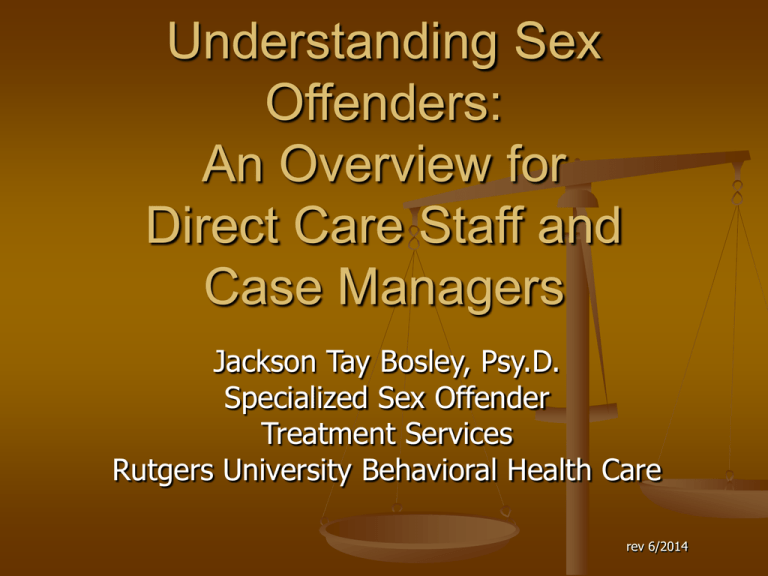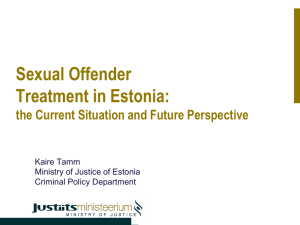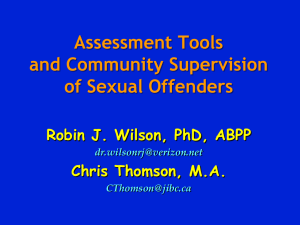
Understanding Sex
Offenders:
An Overview for
Direct Care Staff and
Case Managers
Jackson Tay Bosley, Psy.D.
Specialized Sex Offender
Treatment Services
Rutgers University Behavioral Health Care
rev 6/2014
Numbers
Between 15,600 and 16,000 Registered
Sex Offenders in New Jersey
5,600 under supervision with the State
Parole Board (Community or Parole
Supervision for Life). Newly convicted
offenders are all under supervision.
Nationwide – about 9% of parolees are
sex offenders. In New Jersey – 30%.
Sex Offenders
Who are sex offenders?
What does “Sex Offender” mean?
Where do they live?
Heterogeniety
Statutory-type offender
Incest offender
Female offender
Exhibitionist
Date rapist/stranger rapist
Male-target pedophiles
Sadistic rape-murderer
Internet offender
Juveniles with sexual behavior problems
Commonalities
Broke a Municipal, State or Federal Law
Problems with sexual arousal (some)
Problems obeying the law (some)
Problems with social interactions (some)
Problems making a living (some)
Problems with drugs (some)
Problems with societal norms (some)
next section: Semantics
Sexual Offender
Legal term (2C:14-2-4)
Broke a municipal, state or federal law
Aggravated Sexual Assault/Sexual Assault
Aggravated Criminal Sexual Contact/Criminal
Sexual Contact
Endangering the Welfare of a Child
Kidnapping, Enticing or Luring, etc.
CSL/PSL (2C:43-6.4)
Sentencing provision
Statutory Age of Consent
in New Jersey
In New Jersey, 16 is the age of consent:
But, 13, 14 and 15 year olds can consent
to sexual behavior with someone up to 4
years older than themselves (to the day).
Teachers/coaches/ministers (in loco
parentis) are prohibited from being sexual
with minors under their supervision.
New Proviso – Endangering Statute
Sexually Violent Predator
Legal term (C.30:4-27.24)
Civil commitment for sex offenders
Prior offense
Mental abnormality or personality disorder
High risk
Volitional impairment
460 (or so) currently committed by court
order, released when risk no longer
reaches a statutorily- defined point.
Pedophilia
Pedophilic Disorder (302.2)
Medical term (one of the paraphilias)
Diagnostic and Statistical Manual of Mental Disorders
(DSM-5)
Over a period of at lest 6 months, recurrent, intense
sexually arousing fantasies, sexual urges or behaviors
involving sexual activity with a prepubescent child or
children (generally age 13 and under).
The individual has acted on the urges, or the sexual
urges or fantasies cause marked distress or
interpersonal difficulty.
Person is at least 16 and at least 5 years older than
the child or children in criterion A.
Rapist/Child Molester
Colloquial terms
Forcing someone to have sex
Engaging in sexual contact with someone
too young to give legal consent
These terms do not appear in NJ state
laws
Not all child molesters are pedophiles
Not all pedophiles are child molesters
Exhibitionistic Disorder (302.4)
Medical term (paraphilia)
Legal term – Indecent Exposure/Lewdness
DSM-5
…recurrent and intense sexual arousal from the
exposure of one’s genitals to an unsuspecting person
as manifested by fantasies, urges or behaviors.
The individual has acted on these sexual urges with a
non-consenting person, or the sexual urges or
fantasies cause clinically significant distress or
impairment in social, occupational or other areas…
Voyeuristic Disorder (302.82)
Medical term (paraphilia)
DSM-5
Over a period of at least 6 months, recurrent and
intense sexual arousal from observing an
unsuspecting person who is naked, in the process of
disrobing or engaging in sexual activity as manifested
by fantasies, urges or behaviors.
Person has acted on these urges or the urges or
fantasies cause marked distress or interpersonal
difficulty.
The individual is at least 18 years of age.
Where do Sex Offenders live/work?
Short answer: everywhere
If under supervision, where they live/work is
determined by their Parole Officer.
Supervision stipulation: can’t live in a home with
children unless approved.
Supervision stipulation: employment must be
approved.
But, many are low-SES, live in urban areas and
depend on public transport.
Why do Sex Offenders
Commit Sex Crimes?
Variety of theories
Personal factors
Finkelhor’s 4 factors:
Sexual arousal (deviant)
Disinhibitors
Biological contributors (sexual arousal)
Contextual factors
Blockages
Emotional congruence
“Rape culture” (socialized norms)
Factors are unique to the individual
Why do Sex Offenders
Commit Sex Crimes? (cont.)
Individual etiology
Ascertained through individual assessment
Empirical factors (Stable/Acute -2007)
ACE (Adverse Childhood Experiences)
Criminal/social/sexual history
Treatment is (should be) based on
assessment
Legal Consequences of Sexual
Offending on the Offender
Criminal sanctions
Megan’s Law
Charges, trial, probation, incarceration
Registration
Community Notification
Community/Parole Supervision for Life
Supervision Conditions
Mandated treatment
Emotional/Social Consequences
on the Offender
The label “sex offender”
Self-esteem
Family shame
Community scorn
Problems/limitations obtaining
Employment
Housing
Problems forming new relationships
Take home messages
Sex offenders are a wide variety of people.
Sex offenders have a wide variety of
problems.
Sex offenders have a wide variety of
recidivism rates (next section).
Sex offenses have serious consequences.
The topic is interesting and complicated.
Who is Likely to
“Do It Again”?
What Science says about
Recidivism
Factor Analysis
(what the science says)
Sexual Deviance
Sexual preference for pre-pubertal sexual
partners (pedophilia)
Sexual preference for cues of pain/fear
Strength of sexual urges (hypersexuality)
Antisociality
Enjoyment of illegal activity
Impulsive
Criminal value system
Actuarials
Rapid Risk Assessment for Sexual Offense
Recidivism (1997)
Minnesota Sex Offender Screening Tool –
Revised (1998)
STATIC-99 and STATIC-99R
Sex Offender Needs Assessment Rating -SONAR
(Stable and Acute-2007)
Others
Sexual Reoffense CARAT, SORAG, JSORRAT-II,
VASOR, SVR-20 (Risk for Sexual Violence Protocol),
Risk Matrix-2000, RSVP
Violent Reoffense VRAG, LSI-R, PCL-R, SAVRY
Actuarial Item Analysis
Actuarial items are chosen based on their
empirical link to recidivism (atheoretical)
Static Factors - Fixed, easy to code, most
researched - priors, age/gender of victim
Dynamic Factors – Changeable, harder to
code (constructs: empathy, stability,
psychopathy), what we target in treatment
– indicators of imminent sexual recidivism
Static Risk Items
Age (youth)
Prior criminal behavior
Non-sexual crimes
Sexual crimes
Number of sentencing occasions
Supervision violations
Sexual offense victim choice
Unrelated, Stranger, Male, Indiscriminate
Static Risk Items
Relationship history
Treatment history
(cont.)
Completion
Failure/termination
Substance abuse history
Adverse childhood environment
Psychological factors/Dx
ASPD, psychosis, DD/MR, pedophilia
Factors Associated With Recidivism
(Hanson & Morton-Bourgon, 2004):
Specific interest in boys
measured by ppg
r = .30
Deviant sexual preference
dx of any paraphilia
.40
Sexual Preoccupations
.51
Emotional identification with
children
.63
Dynamic Risk Items
Stable
(from Stable-2007)
(score 0, 1, or 2)
Significant social influences
Capacity for relationship stability
Emotional identification with children (<13)
Hostility toward women
General social rejection
Lack of concern for others
Impulsive
Dynamic Risk Items
Stable
(cont.)
Poor problem-solving skills
Negative emotionality
Sex Drive/Preoccupation
Sex as coping
Deviant sexual preference
Cooperation with supervision
(from Stable-2007)
Dynamic Risk Items
(from Acute-2007)
type of recidivism
Acute
Victim access
Hostility
Sexual preoccupation
Rejection of supervision
Emotional collapse
Collapse of social supports
Substance abuse
sexual
x
x
x
x
general
x
x
x
x
x
x
x
Other Potential Risk Indicators
Plethysmograph results
Abel Assessment of Sexual Interest
Polygraph results
Treatment response
Categorical denial
(In)ability to empathize
Psychosis
Percentage Rates of Sex Offender Recidivism
(Harris & Hanson, 2004):
Type
All
Rapists
Incest
Female target CM
Male target CM
w/out prior offense
w/ prior offense
Offender over 50yrs
5yr
14
14
6
9
23
10
25
7
10yr
20
21
9
13
28
15
32
11
k=95
15yr
24
24
13
16
35
19
37
13
n=31,000
Criminal Recidivism Rates
US Dept. of Justice (Bureau of Justice
Statistics, 2002) 3 year follow-up
Burglary
Larceny
Auto theft
DUI
Sex offenses
74%
75%
70%
51%
5.3%
n=9691
Megan’s Law Tiering
Registrant Risk Assessment Scale (adults)
Juvenile Risk Assessment Scale (juveniles)
These are not purely risk (recidivism)
scales, but factor in seriousness of the
offense if reoffense occurs.
These scales have shown moderate
concurrent validity with actuarials.
Scores based on all credible information.
Tiers and Notification
Tier 1. Low risk
Tier 2. Moderate risk
Police notified (with registration)
Police and community groups notified
Internet notification (except incest)
Tier 3. High risk
Police, community groups and general public
Internet notification
GPS tracking
Take Home Message:
Adults:
Baseline risk is determined by actuarials.
Dynamic factors determine ongoing risk,
imminence of reoffense and targets of
treatment interventions.
Juveniles:
The research is less definite, but structured
empirically-based instruments are essential.
Contextual issues are of major importance in
determining ongoing risk.
What Can We Do
About It?
Characteristics of
Effective Sexual Offender
Treatment
Basic Elements
Community safety is an overarching goal
Not voluntary – Motivation is a major issue
Group-based
Challenging
Directed towards specific problems of sex
offenders – Criminogenic needs
Developmental/Contextual model
This is NOT standard counseling (but has
many aspects of general counseling)
Treatment Models
Legacy models
One size fits all
Harsh and confrontational
Relapse Prevention (still used)
Modern understanding
Based on Risk/Need/Responsivity
More risk – more (intensive & lengthy) treatment
Address treatment to specific problem areas
Provide treatment in a way that client can
understand
Specific Problems of Sexual
Offenders
Deviant sexual arousal
Distorted cognitions/attitudes
Antisocial value system
Poor interpersonal functioning
Poor problem-solving skills
Poor coping mechanisms
Denial
Protective Factors
Pro-social attitudes
Lifestyle stability
Respect for the law
Desire to live a law-abiding lifestyle
Steady, safe, affordable housing
Living wage job
Community supports
Reasonable legal supervision
Family/colleagues (non-criminal)
Intervention Philosophy
Collaborative effort
(client onboard?)
Accountability
Limited confidentiality
Skill building (work & social relationships)
Risk/Need/Responsivity principle
Accurate feedback
Reinforce positive behaviors
Challenge antisocial thinking/lifestyle
Intervention Techniques
Explicit CBT
Ancillary techniques
Examine distorted cognitions
Enhance positive behavioral repertoire
Polygraph
Collaborative surveillance
Medications (SSRIs and antiandrogens)
Relapse Prevention
Good Lives Model (strengths based)
Relapse Prevention
Offending behavior does not just
“happen.”
Offenders make a series of choices.
Treatment teaches offenders to recognize
those choices.
Intervention:
Offenders learn about their offense cycles.
Offenders learn to identify risk factors.
Offenders learn to respond appropriately.
CSOM Long Version: Section 3
42
Modern Sexual Offender
Treatment Approaches
Treatment based on assessment
Treatment that teaches new skills
Treatment targets vary with individual
Teach better coping skills
Teach new social-interactional skills
Time in treatment varies
Short for some (statutory-type offenders)
Long time/forever for some (psychopaths and
pedophiles)
Treatment Effectiveness
Treatment has a positive effect for
reducing recidivism (40% reduction).
Failing treatment is a very poor
prognosticator (200% increase in recid.).
Treatment “works” for those who are
invested in the process and “work the
program”.
Treatment has less effect for those who
attend, but are not invested.
Other Treatment Effectiveness
Studies
Furby, L., Weinrott, M.R., & Blackshaw, L. (1989)
Hanson, R. K., Gordon, A., Harris, A. J. R., Marques, J.
K., Murphy, W., Quinsey, V. L., & Seto, M. C. (2002)
SOTEP study “…there is as yet, no evidence that that clinical
treatment reduces rates of sexual reoffenses.”
10% Treated
17% Untreated
n = 9454
Hanson, R. K., Bourgnon, G., Helmus, L., & Hodgson, S.
(2009)
10.9% Treated
19.2% Untreated
n = 6746
Take Home Message
Treatment works (most of the time).
Treatment is lengthy and difficult.
The early stages are particularly difficult.
Denial is an important issue.
Treatment is usually based on
Cognitive/Behavioral Principles.
Risk/Need/Responsivity (triage) is an
abiding principle.
Honor the efforts you make to
reduce suffering in the world.
Contact Information:
Jackson Tay Bosley, Psy.D.
(609) 984-6280 Cell (201) 259-5228
bosleyjt@ubhc.rutgers.edu










